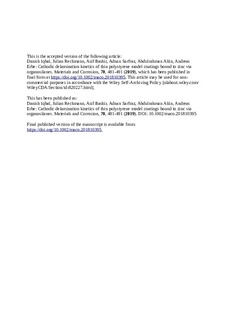| dc.contributor.author | Iqbal, Danish | |
| dc.contributor.author | Rechmann, Julian | |
| dc.contributor.author | Bashir, Ali | |
| dc.contributor.author | Sarfraz, Adnan | |
| dc.contributor.author | Altin, Abdulrahman | |
| dc.contributor.author | Erbe, Andreas | |
| dc.date.accessioned | 2019-03-05T13:30:48Z | |
| dc.date.available | 2019-03-05T13:30:48Z | |
| dc.date.created | 2018-12-13T16:48:38Z | |
| dc.date.issued | 2018 | |
| dc.identifier.citation | Materials and corrosion - Werkstoffe und Korrosion. 2018, 70 481-491. | nb_NO |
| dc.identifier.issn | 0947-5117 | |
| dc.identifier.uri | http://hdl.handle.net/11250/2588805 | |
| dc.description.abstract | The cathodic delamination of poly(styrene) [PS] model coatings from oxidecovered
zinc has been evaluated by scanning Kelvin probe (SKP). Linear and
acrylate cross-linked PS model coatings covalently bound to zinc oxide via
Zn─O─Si bonds have been prepared. PS was prepared by thermally initiated free
radical polymerization in the presence of vinyltrimethoxy silane modified zinc.
Cross-linkers ethylene glycol diacrylate (EDA) and hexanediol diacrylate (HDA)
were used in some preparations. Resulting polymers are 8–15 nm thick. PS model
coatings show a delamination rate of only ≈20% of that of comparable
poly(methyl methacrylate) [PMMA] samples. The slower cathodic delamination
of PS is attributed to denser chain packing and higher amounts of hydrophobic
moieties, leading to a reduction in penetration of corrosive species. As opposed to
the situation in PMMA, the addition of HDA increases the delamination rate, due
to its flexible chains and hydrophilic groups. The lowest delamination rate is
observed in the presence of 25% EDA. Consequently, ester hydrolysis of acrylates
accelerates delamination, it is however not the main factor in cathodic
delamination of such thin model system. | nb_NO |
| dc.language.iso | eng | nb_NO |
| dc.publisher | Wiley | nb_NO |
| dc.title | Cathodic delamination kinetics of thin polystyrene model coatings bound to zinc via organosilanes | nb_NO |
| dc.type | Journal article | nb_NO |
| dc.type | Peer reviewed | nb_NO |
| dc.description.version | acceptedVersion | nb_NO |
| dc.source.pagenumber | 481-491 | nb_NO |
| dc.source.volume | 70 | nb_NO |
| dc.source.journal | Materials and corrosion - Werkstoffe und Korrosion | nb_NO |
| dc.identifier.doi | 10.1002/maco.201810395 | |
| dc.identifier.cristin | 1642982 | |
| dc.description.localcode | Postprint: Locked until 10.09.2019 due to copyright restrictions. This is the peer reviewed version of an article, which has been published in final form at 10.1002/maco.201810395. This article may be used for non-commercial purposes in accordance with Wiley Terms and Conditions for Self-Archiving. | nb_NO |
| cristin.unitcode | 194,66,35,0 | |
| cristin.unitname | Institutt for materialteknologi | |
| cristin.ispublished | true | |
| cristin.fulltext | postprint | |
| cristin.qualitycode | 1 | |
